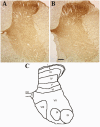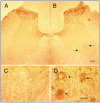Retraining the injured spinal cord
- PMID: 11351008
- PMCID: PMC2278598
- DOI: 10.1111/j.1469-7793.2001.0015b.x
Retraining the injured spinal cord
Abstract
The present review presents a series of concepts that may be useful in developing rehabilitative strategies to enhance recovery of posture and locomotion following spinal cord injury. First, the loss of supraspinal input results in a marked change in the functional efficacy of the remaining synapses and neurons of intraspinal and peripheral afferent (dorsal root ganglion) origin. Second, following a complete transection the lumbrosacral spinal cord can recover greater levels of motor performance if it has been exposed to the afferent and intraspinal activation patterns that are associated with standing and stepping. Third, the spinal cord can more readily reacquire the ability to stand and step following spinal cord transection with repetitive exposure to standing and stepping. Fourth, robotic assistive devices can be used to guide the kinematics of the limbs and thus expose the spinal cord to the new normal activity patterns associated with a particular motor task following spinal cord injury. In addition, such robotic assistive devices can provide immediate quantification of the limb kinematics. Fifth, the behavioural and physiological effects of spinal cord transection are reflected in adaptations in most, if not all, neurotransmitter systems in the lumbosacral spinal cord. Evidence is presented that both the GABAergic and glycinergic inhibitory systems are up-regulated following complete spinal cord transection and that step training results in some aspects of these transmitter systems being down-regulated towards control levels. These concepts and observations demonstrate that (a) the spinal cord can interpret complex afferent information and generate the appropriate motor task; and (b) motor ability can be defined to a large degree by training.
Figures







References
-
- Barbeau H, Mccrea DA, o'donovan MJ, Rossignol S, Grill WM, Lemay MA. Tapping into spinal circuits to restore motor function. Brain Research. 1999;30:27–51. - PubMed
-
- de Leon RD, Hodgson JA, Roy RR, Edgerton VR. Locomotor capacity attributable to step training versus spontaneous recovery following spinalization in adult cats. Journal of Neurophysiology. 1998a;79:1329–1340. - PubMed
-
- de Leon RD, Hodgson JA, Roy RR, Edgerton VR. Full weight-bearing hindlimb standing following stand training in the adult spinal cat. Journal of Neurophysiology. 1998b;80:83–91. - PubMed
-
- de Leon RD, Hodgson JA, Roy RR, Edgerton VR. Retention of hindlimb stepping ability in adult spinal cats after the cessation of step training. Journal of Neurophysiology. 1999a;81:85–94. - PubMed
-
- de Leon RD, Tamaki H, Hodgson JA, Roy RR, Edgerton VR. Hindlimb locomotor and postural training modulates glycinergic inhibition in the spinal cord of the adult spinal cat. Journal of Neurophysiology. 1999b;82:359–369. - PubMed
Publication types
MeSH terms
LinkOut - more resources
Full Text Sources
Other Literature Sources
Medical

